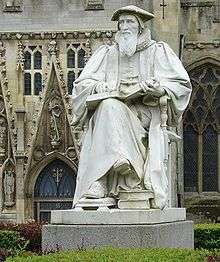Congress of St. Louis
The 1977 Congress of St. Louis was an international gathering of nearly 2,000 Anglicans united in their rejection of theological changes introduced by the Anglican Church of Canada and by the Episcopal Church in the United States of America in its General Convention of 1976. Anglicans who attended this congress felt that these changes amounted to foundational alterations in the American and Canadian provinces of the Anglican Communion and meant that they had "departed from Christ's One, Holy, Catholic and Apostolic Church."[1]
The Congress of St. Louis produced the Affirmation of St. Louis which authorized the formation of the "Anglican Church in North America (Episcopal)". Although it was not put to a vote at the Congress, most Continuing Anglican churches nevertheless consider it to be an official statement of their faith. Despite the plans for a united North American church, the result was division into several Continuing Anglican churches: the Anglican Catholic Church, the Holy Catholic Church (Anglican Rite), the Anglican Province of Christ the King, the United Episcopal Church of North America, and the Anglican Catholic Church of Canada.
The Affirmation has several general tenets:
- Dissolution of Anglican Church structures: That the churches to which the delegates had previously belonged had ceased to have a valid ministry through the act of ordaining women to the priesthood.
- Continuation of Anglicanism: That Anglicanism could only continue through a complete separation from the structures of the Episcopal Church in the USA and the Anglican Church of Canada.
- Invalidity of Schismatic Authority: That the churches to which the delegates had previously belonged had made themselves schismatic by their break with traditional order and, therefore, had ceased to have any authority over them or other members.
- Continued Communion with Canterbury: That communion with Canterbury would continue because the Church of England had not, at that time, ordained women to the priesthood. This article of the Affirmation became inoperable with the ordination of women by the Church of England in 1990s.
These continuing churches are described by the Affirmation of St. Louis as maintaining the faith and practices of the Anglican Church rather than breaking away from it, since it was the Episcopal Church in the United States of America and the Anglican Church of Canada which introduced the changes seen by the delegates in St. Louis as amounting to a departure from scripture, the Anglican tradition, and the "One, Holy, Catholic and Apostolic Church".[1] Theological liberalism, revisions to the Book of Common Prayer, and the ordination of women priests were not the only reasons for the split, but they were seen by these churches as evidence of the mainline church's departure from Anglican orthodoxy.[2]
References
External links
- The Affirmation of St. Louis, full text of the document.
- About The Anglican Catholic Church, a section containing history of the ACC.
- Walking Apart, a wiki documenting actions by and milestones of ECUSA in their perceived departure from Anglicanism.
